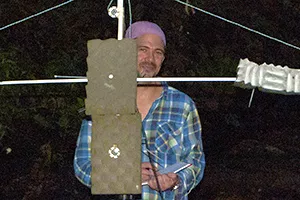
'Batman' returns to U of T Mississauga
Bats – winged creatures that hunt in the night. For some, it’s the stuff of nightmares.
But for new U of T Mississauga professor John Ratcliffe, bats are one of nature’s wonders.
Ratcliffe, a former PhD student at U of T Mississauga, has traveled the world to further the study of bats and echolocation. His research in the neuroethology and ecology of echolocating bats has led him to the tropics of Central and South America, parts of Africa and India, and islands in the south Pacific.
For the past six years, Ratcliffe served first as a postdoctoral then as an assistant professor at the University of Southern Denmark. In January this year, Ratcliffe returned to Mississauga to serve as an assistant professor in the Department of Biology at U of T Mississauga.
Ratcliffe will instruct a third-year course in sensory biology and a fourth-year course in the evolution of animal cognition. His return to Mississauga will also afford him the opportunity to study local bat populations. Five residence species of bats and three migratory species inhabit the area around U of T Mississauga.
Ratcliffe has a particular fondness for the northern long-eared bat common in the caves and tree hollows along the Credit River. Unlike most bats that snare insects from the skies, the northern long-eared bat is also a specialist at taking moths and katydids from leaves and other surfaces.
But it is the outbreak of white-nose syndrome among local populations of the northern long-eared bat and the little brown bat that has Ratcliffe and other North American bat researchers gravely concerned.
“White nose-syndrome is having a devastating impact on bats,” Ratcliffe said.
“It’s a fungus that forms of the face and in the respiratory tract and can cause bats to wake prematurely from hibernation in winter. Once the bat is awake it starts to burn a lot of energy trying to warm itself up. By the time spring arrives these bats are often underweight or dying from starvation.”
Ratcliffe completed his PhD at U of T Mississauga back in 2005 under the late Professor James Fullard and Professor Emerita Sara Shettleworth.
While he admits a life-long fascination of bats, Ratcliffe’s research into echolocation has also led to studies of insects, oilbirds and porpoises.
“My studies have primarily been focused on how bats detect and localize prey and how they are able to differentiate poisonous from edible prey,” he said.
“Bats are much longer lived than most animals their size. Some bats can live past 40 years and across species can vary from a kilogram-and-a-half in size to two grams.
“Most species of the 1200 or so alive today produce only a single offspring each year. I’ve been very fortunate to have been able to travel the world studying them.”
